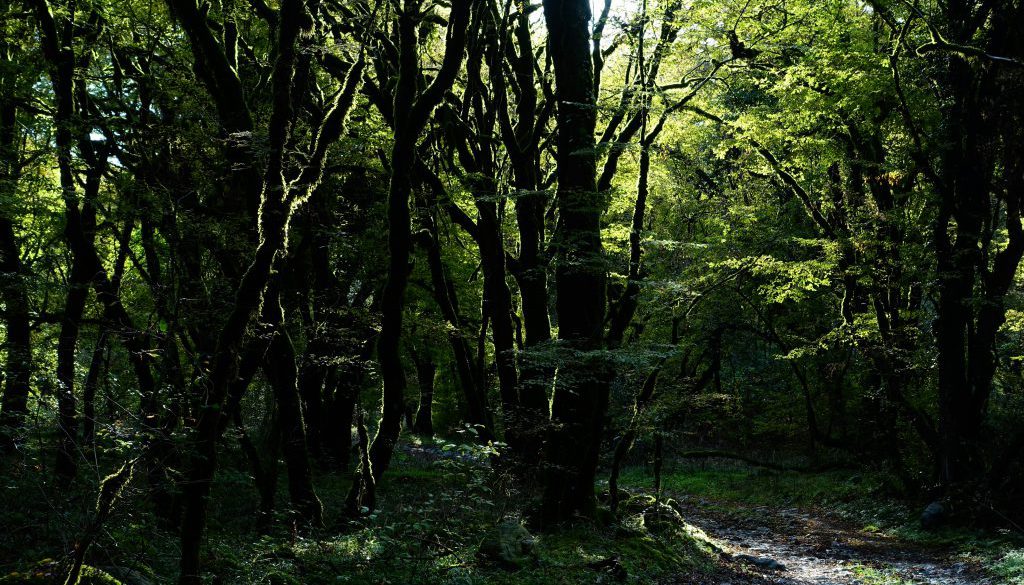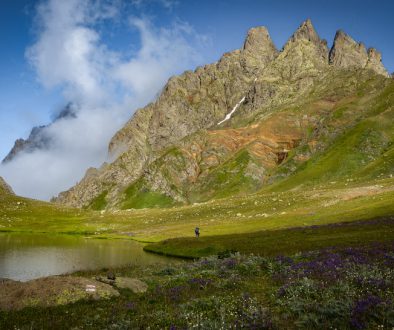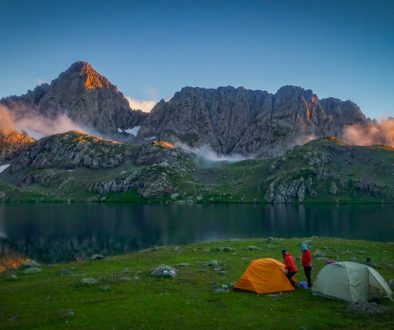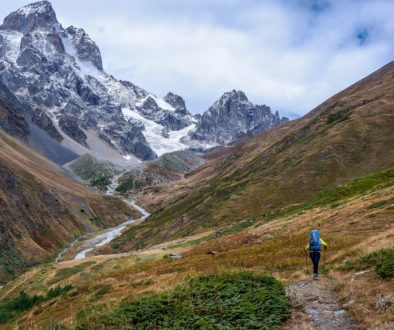New Trail Projects: An Eastern Georgia Link in Lagodekhi National Park
Thick sunlight is dripping through the tree canopy, illuminating mossy branches of ancient hornbeam trees. We cross one gurgling stream, winding its way through a carpet of green, then another, and the forest itself seems to glow in the moist rising heat after a rain shower. It’s early November — and still green, still glowing — and we’re packing out from a volunteer weekend spent fixing a particularly tricky section of trail. Soft fallen leaves pad our footsteps as we hike. As usual after a day of trail work, we’re tired, sweaty, and laughing.
Welcome to Lagodekhi National Park, in eastern Georgia.
While most of the TCT’s work in Georgia over the past few years has been focused on Svaneti and the link to Racha, we’ve also been expanding. Lagodekhi, Georgia’s oldest protected area, proved to be an ideal place to work next.
Originally protected as a nature reserve in 1912, Lagodekhi is wildly diverse in flora and fauna, stretching from dense, subtropical lowland forest to alpine meadows more than 3,000 meters high. Equally important, the forward-thinking Lagodekhi administration was excited about the idea of the TCT. And it will be a perfect start or end point for the northern TCT route in Georgia: Across a river on the eastern edge of the park is Azerbaijan’s Zaqatala Nature Reserve, which we hope to one day link with Lagodekhi.
We started our first trail project in Lagodekhi this past autumn. And this year, we’re excited to launch another– whenever, of course, we’re able to safely get back to the trails.

2019: Improving the Machi Fortress Trail
At the start of 2019, the Georgia team began making trips to Lagodekhi to scout potential routes for the TCT in eastern Georgia towards the Azerbaijani border and to start conversations with the park administration. Paul, Sopo, and Giorgi spent several days bushwhacking in search of safe river crossings and learning about old trails from the Lagodekhi rangers. Later, based on priorities identified with the Lagodekhi administration, we put together plans for various trail improvements.
We started work on the first of those, the Machi Fortress trail, in autumn 2019. The Machi Fortress trail travels through forest for about 6 kilometers before ending at the crumbled, vine-covered remains of a 7th-century fortress. It’s one of the few “easy” trails in Georgia– most of the trail is wide and gentle. But a few tricky sections of trail– steep, eroding sections with drops; stream crossings; slippery bridges over rivers with no handrails– still pose major accessibility issues.

Over four weekends in October and November, we organized weekend crews of local volunteers to start tackling a few of these key issues. We cleared overgrown vegetation from 5 kilometers of trail (for both human and equestrian use, since rangers and visitors often ride horses there). We widened and improved a 100-meter section of particularly steep and narrow trail. And we built two new 4-meter bridges for stream crossings and fixed a 9-meter bridge over a larger river near the fortress (including a sturdy new handrail!).


While the Machi Fortress trail won’t be on the TCT itself, it will make a great day trip as a side trail. We also wanted to invest in our long-term relationship with Lagodekhi National Park and to show what our crews can accomplish, in order to lay the groundwork for future work on the TCT in Lagodekhi, so we were happy to lend assistance to one of their priorities.
We got the chance to revisit our crews’ work in January, when borders were still open and our Armenia and Georgia teams gathered for a few days of in-person meetings. With the exception of an issue with one of the smaller bridges, we were happy to find the work holding up well, and we were glad to hear that the Lagodekhi staff were pleased with the results. More remains to be done on this trail to make it more accessible, but we made some crucial steps.

2020: Linking Matsimi ranger station and Lagodekhi National Park visitor center
Although the Machi Fortress trail is in the National Park, it’s not connected to the rest of the park’s trail network. Instead, you need to drive from the visitor center over to the village of Matsimi, a border town in eastern Georgia adjacent to Azerbaijan, to reach the trailhead.
With no connection through the park from the main visitor center, most people don’t visit Machi Fortress. We thought a connection to the main area would increase the numbers of trail users. Having more trail options also tends to increase the amount of days people spend visiting national parks, so this would likely translate into more income for guesthouses and tourism services in the nearby communities. And if you could easily hike to the main area of Lagodekhi from Matsimi, we anticipate that this would lead to an increase in guesthouses and other businesses in Matsimi– which the community has already expressed interest in developing. (For TCT hikers, this connection would also have great benefits– enabling a thru-hiker to reenter the woods nearly immediately after crossing the border from Azerbaijan, replacing a long slog on a major road with a beautiful forest walk.)
So, we asked the Lagodekhi rangers about it. We learned that, sure enough, there was an old trail that a few rangers and locals used to move between the visitor center and the ranger station, but it wasn’t maintained or marked on the maps.
Perfect!
So at the start of this year, Giorgi and Vakho started making trips to scout out this potential new trail. They found an unkempt trail that was partially completed, interrupted by a large landslide. Higher on the hill, there was an old church in the forest, which dates back to at least the 7th century. Over several trips to survey the land, Giorgi and Vakho stitched together a proposed new route that would skirt above the landslide and pass by the church for a historical resting point, ultimately creating a new 10-kilometer trail that would enable rangers and visitors alike to traverse the forest more easily.
The Lagodekhi staff were enthusiastic about this plan and gave us approval to go ahead. Unfortunately, due to the current COVID-19 situation, our plans to send crews out in the spring have now been postponed. But we’re looking forward to getting crews out there and start digging the first section of the TCT in Lagodekhi as soon as possible!


Beyond 2020: Expanding the TCT in Lagodekhi
So, how will the Matsimi connection fit in with the broader TCT?
Eventually, we aim for one endpoint of the TCT in Georgia to be in Matsimi, near the Azerbaijani border. The trail will then enter Lagodekhi National Park via the Mastimi ranger station and take the new trail to traverse the lowland forests to the main Lagodekhi ranger station.
After that, hikers will climb the trail to spectacular Black Rock Lake at 2850m. Then they’ll continue west towards the highlands of Tusheti National Park.
In the other direction, we hope to eventually start cross-border collaboration with Azerbaijan’s Zaqatala Nature Reserve.
We’re still just at the start of this expansion, but we’re so excited to be digging in.

Want to stay up-to-date on our future work in Lagodekhi and elsewhere (including volunteer opportunities)? You can subscribe to our mailing list here. We’ll announce all open volunteer opportunities there.
Want to support our future expansion? You can do that here, too. 🙂 We’re extraordinarily grateful to the small, passionate group of supporters that has enabled our work thus far– especially during these challenging times for all.
See you on the trails!






